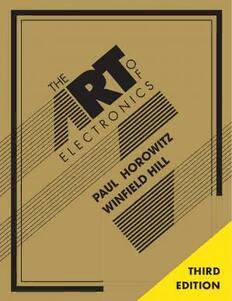
The Art of Electronics (3rd edition) PDF
Preview The Art of Electronics (3rd edition)
O F E H S T C I N O R T C Z T E I W L O E R L L O I H H D L L U E A I F P N I W THIRD EDITION The Art of Electronics ThirdEdition At long last, here is the thoroughly revised and updated, and long-anticipated, third edition of the hugely successful The Art of Electronics. Widely accepted as the best single authoritative text and reference on electronic circuit design, bothanaloganddigital,thefirsttwoeditionsweretranslatedintoeightlanguages,andsoldmorethanamillioncopies worldwide.Theartofelectronicsisexplainedbystressingthemethodsactuallyusedbycircuitdesigners–acombination of some basic laws, rules of thumb, and a nonmathematical treatment that encourages understanding why and how a circuitworks. Paul Horowitz is a Research Professor of Physics and of Electrical Engineering at Harvard University, where in 1974 heoriginatedtheLaboratoryElectronicscoursefromwhichemergedTheArtofElectronics.Inadditiontohisworkin circuitdesignandelectronicinstrumentation,hisresearchinterestshaveincludedobservationalastrophysics,x-rayand particlemicroscopy,andopticalinterferometry.HeisoneofthepioneersofthesearchforintelligentlifebeyondEarth (SETI).Heistheauthorofsome200scientificarticlesandreports,hasconsultedwidelyforindustryandgovernment, andisthedesignerofnumerousscientificandphotographicinstruments. WinfieldHillisbyinclinationanelectronics circuit-designguru.Afterdropping outoftheChemical Physics graduate programatHarvardUniversity,andobtaininganE.E.degree,hebeganhisengineeringcareeratHarvard’sElectronics DesignCenter.After7yearsoflearningelectronicsatHarvardhefoundedSeaDataCorporation,wherehespent16years designinginstrumentsforPhysicalOceanography.In1988hewasrecruitedbyEdwinLandtojointheRowlandInstitute forScience.TheinstitutesubsequentlymergedwithHarvardUniversityin2003.Asdirectoroftheinstitute’sElectronics EngineeringLabhehasdesignedsome500scientificinstruments.Recentinterestsincludehigh-voltageRF(to15kV), high-currentpulsedelectronics(to1200A),low-noiseamplifiers(tosub-nVandpA),andMOSFETpulsegenerators. This page intentionally left blank THE ART OF ELECTRONICS Third Edition Paul Horowitz HARVARD UNIVERSITY Winfield Hill ROWLAND INSTITUTE AT HARVARD 32AvenueoftheAmericas,NewYork,NY10013-2473,USA CambridgeUniversityPressispartoftheUniversityofCambridge. ItfurtherstheUniversity’smissionbydisseminatingknowledgeinthepursuitof education,learning,andresearchatthehighestinternationallevelsofexcellence. www.cambridge.org Informationonthistitle:www.cambridge.org/9780521809269 ©CambridgeUniversityPress,1980,1989,2015 Thispublicationisincopyright.Subjecttostatutoryexception andtotheprovisionsofrelevantcollectivelicensingagreements, noreproductionofanypartmaytakeplacewithoutthewritten permissionofCambridgeUniversityPress. Firstpublished1980 Secondedition1989 Thirdedition2015 7thprinting2016withcorrections PrintedintheUnitedStatesofAmerica AcatalogrecordforthispublicationisavailablefromtheBritishLibrary. ISBN978-0-521-80926-9Hardback CambridgeUniversityPresshasnoresponsibilityforthepersistenceor accuracyofURLsforexternalorthird-partyInternetwebsitesreferredto inthispublicationanddoesnotguaranteethatanycontentonsuch websitesis,orwillremain,accurateorappropriate. To Vida and Ava This page intentionally left blank In Memoriam: Jim Williams, 1948–2011 This page intentionally left blank CONTENTS ListofTables xxii 1.6.5 Regulators 34 1.6.6 Circuitapplicationsofdiodes 35 PrefacetotheFirstEdition xxv 1.6.7 Inductiveloadsanddiode protection 38 PrefacetotheSecondEdition xxvii 1.6.8 Interlude:inductorsasfriends 39 1.7 Impedanceandreactance 40 PrefacetotheThirdEdition xxix 1.7.1 Frequencyanalysisofreactive circuits 41 ONE: Foundations 1 1.7.2 Reactanceofinductors 44 1.1 Introduction 1 1.7.3 Voltagesandcurrentsas 1.2 Voltage,current,andresistance 1 complexnumbers 44 1.2.1 Voltageandcurrent 1 1.7.4 Reactanceofcapacitorsand 1.2.2 Relationshipbetweenvoltage inductors 45 andcurrent:resistors 3 1.7.5 Ohm’slawgeneralized 46 1.2.3 Voltagedividers 7 1.7.6 Powerinreactivecircuits 47 1.2.4 Voltagesourcesandcurrent 1.7.7 Voltagedividersgeneralized 48 sources 8 1.7.8 RChighpassfilters 48 1.2.5 The´veninequivalentcircuit 9 1.7.9 RClowpassfilters 50 1.2.6 Small-signalresistance 12 1.7.10 RCdifferentiatorsand 1.2.7 Anexample:“It’stoohot!” 13 integratorsinthefrequency 1.3 Signals 13 domain 51 1.3.1 Sinusoidalsignals 14 1.7.11 Inductorsversuscapacitors 51 1.3.2 Signalamplitudesanddecibels 14 1.7.12 Phasordiagrams 51 1.3.3 Othersignals 15 1.7.13 “Poles”anddecibelsperoctave 52 1.3.4 Logiclevels 17 1.7.14 Resonantcircuits 52 1.3.5 Signalsources 17 1.7.15 LCfilters 54 1.4 Capacitorsandaccircuits 18 1.7.16 Othercapacitorapplications 54 1.4.1 Capacitors 18 1.7.17 The´venin’stheoremgeneralized 55 1.4.2 RCcircuits:V andIversustime 21 1.8 Puttingitalltogether–anAMradio 55 1.4.3 Differentiators 25 1.9 Otherpassivecomponents 56 1.4.4 Integrators 26 1.9.1 Electromechanicaldevices: 1.4.5 Notquiteperfect... 28 switches 56 1.5 Inductorsandtransformers 28 1.9.2 Electromechanicaldevices: 1.5.1 Inductors 28 relays 59 1.5.2 Transformers 30 1.9.3 Connectors 59 1.6 Diodesanddiodecircuits 31 1.9.4 Indicators 61 1.6.1 Diodes 31 1.9.5 Variablecomponents 63 1.6.2 Rectification 31 1.10 A parting shot: confusing markings and 1.6.3 Power-supplyfiltering 32 itty-bittycomponents 64 1.6.4 Rectifierconfigurationsfor 1.10.1 Surface-mounttechnology:the powersupplies 33 joyandthepain 65 ix
